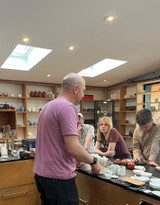A Deep Dive Into Puer: Tasting, Teaching, and Transformation

Curious about puer tea and what makes it different from other teas? In this post, I share highlights from a recent puer-focused tasting at the tea house. We brewed five raw puers and a rock oolong, explored what makes puer unique, and talked about how these teas can be transformative—not just in taste, but in how they make you feel.
This weekend at the tea house, we hosted a puer-focused tasting that brought together about a dozen tea lovers. The room was full of curiosity, questions, and, of course, some remarkable teas.
The Lineup: Five Raw Puers + A Rock Oolong
We started with a new rock oolong that just arrived in stock. It is a Lao Cong Shui Xian and we have dubbed it Water Spirit Rock Oolong. It has a chocolatey, toasty, roasted character with plenty of complexity to carry through multiple infusions. Compared to a higher grade I once had, this version leans a little heavier on the roast and a bit lighter on lingering sweetness. At first I was slightly disappointed—but judged on its own, it’s a great tea. I’ve priced it with a very minimal markup so it’s a good value, and you can now even find it in bulk at Sundance Natural Foods.
To finish, we brewed five raw puers, each one offering a unique expression of this fascinating category. Three of them were from the JXJS Auspicious brand (2011 and 2012 harvests), followed by a 2013 Chen Sheng Hao Banzhang Gold Mark, and finally the 2008 Liming Bafangting "Elegant Rhyme Raw Cake". These were high-grade teas—some soft and textured, others bold and commanding.
What Makes Puer Different?
During the tasting, a big question came up: What exactly makes puer, puer?
Most teas are “fixed” with high heat—pan-firing, steaming, or roasting—to halt oxidation. This locks in the tea’s flavor profile: green teas stay fresh and grassy, black teas become fully oxidized, oolongs more fruity, floral and somewhere in between.
Puer, however, is treated differently. The “kill-green” step is lighter. The time that the tea is exposed to the heat is much quicker, which means some enzymes and microbes survive. Instead of freezing the tea in time, puer is meant to keep evolving. During storage, heat, humidity, microbes, and seasonal cycles continue to transform the leaves. Over the years, the tea becomes smoother, darker, and more complex.
This is why Taiwan is prized for storage. Its microbial environment, warmth, humidity, and seasonal fluctuations give puer just the right conditions to age gracefully. And it’s also why cooked puer was developed in the 1970s—to imitate, in a matter of months, what naturally aged raw puer takes years to achieve.
What Is Puer Tea?
Puer is a tea designed to change after it’s made.
– Fixed lightly so enzymes and microbes survive
– Transforms through microbial and enzymatic fermentation in storage
– Ages like fine wine, becoming smoother and richer over time
More Than “Do You Like It?”
One of the most interesting conversations during this tasting and tastings like this is about how we approach tea. With everyday flavors—like strawberries or ice cream—the question is simply, “Do you like it?” But puer challenges us differently.
Transformative experiences are rarely easy or instantly enjoyable. Puer isn’t just about liking or disliking—it’s about how it makes you feel.
- What is its vibration?
- How does it shift your energy?
- What questions does it leave you with?
For me, a few small cups of high-grade puer are enough to create a sensation. The sensation is difficult to describe. A vibration is the closest I can come, because it feels as though some of the layers in my skin or below my skin are singing and vibrating. Puer isn’t just a beverage, it is a journey.
And like the best journeys, it rarely ends with answers—only with better questions.
If you missed this tasting, I hope you’ll join the next one. To find out about our next upcoming tea tasting, please sign up for the newsletter. This is where we let you know about tea house events and new teas that have come into the shop. Thanks so much for reading!
